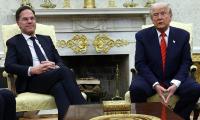Since the cold war, the world’s middle powers have played a prominent role in geopolitics. They have acted like a few strong players on a football team while the great powers have led these teams as captains.
During this period, the ‘traditional middle powers’ were Western Global North countries. These middle powers were considered the best players due to their developed economies, resilient defence industry, vibrant democracy, significant diplomatic weight, soft power and so on. However, as we are witnessing a shift in the global order, the global football arena has expanded with new teams and strong players. These are often termed as ‘emerging middle powers’ or emerging players.
Experts estimate that there are at least two dozen middle powers in the world at present and counting. Some are 'traditional' middle powers while most are 'emerging' middle powers. These emerging middle powers have altered the scope and understanding of middle powers. Unlike the traditional middle powers, the emerging middle powers comprise a heterogeneous group with varying economic ranking, significant military muscle, and diverse governance structures. The emerging world order has some distinct features of middle powers.
First, unlike the traditional middle powers, the team of emerging middle powers is not necessarily from the Global North; rather it also includes countries of the Global South. Likewise, these are not necessarily developed countries; a growing number of developing countries with medium-range capabilities can acquire the status of middle power now.
Second, regardless of their heterogeneous features, emerging middle powers heavily rely on diplomacy. They tend towards coalition-building and cooperation to cultivate diplomatic weight. They follow niche diplomacy and focus on issues such as disarmament, climate change, emerging technologies, or specific regional or global conflicts. Although emerging middle powers follow independent paths, they favour multilateralism, which is one of the dominant features of middle-power politics.
Third, middle powers have positioned themselves in a manner that they exercise greater leverage in terms of their diplomatic flexibility. They can engage with either of the warring sides, great powers, smaller powers, traditional middle powers as well as with other emerging middle powers. The emerging middle powers can make a significant diplomatic mark. This diplomatic mark does not necessarily change the world, but it is considered a vital success for the middle powers.
Fourth, the emerging middle powers act as stabilizers of the global order by exercising strategic balancing rather than siding with one power. This practice allows them to manage great power contestation and ensures independence to work with other great powers.
Lastly, middle powers can leverage their unique knowledge and geostrategic position to generate influence on international platforms. The credibility and weight of middle powers on the international platform are therefore becoming significantly imperative.
Regardless of their impressive coalition-building and diplomatic acumen, middle powers have limited influence over great powers and alteration of global decisions. This limitation inherently restricts their impact on global peace and justice. Historically, the role of middle powers is limited to acting as facilitators or in rare instances as mediators. Nevertheless, in the emerging global order, middle powers can play a more dynamic role in three perspectives.
Middle powers can strengthen inclusive multilateralism to address global threats and challenges. The emerging threats, from regulating technological advancements to climate change, transcend borders. Unilateralism or exclusive groups will be stretched too thin to develop globally applicable solutions. This necessitates the concerted energies of middle powers and the power of true multilateralism to find effective solutions. Middle powers must chip in and share the responsibility.
Middle powers can act as facilitators of peaceful settlement of disputes. This responsibility would not only include de-escalation of the conflict but, most importantly, focus on stages after this. This would include bringing the conflicting parties to a negotiating table and pushing for conflict prevention, settlement and peace-building efforts. The middle powers may place a strong emphasis on the provisions of Chapter 6 and the secretary general's good offices (Article 99) and urge their utilization to the optimal level to promote peace.
Middle powers can help reduce the great power contestation rather than fanning it. This not only exacerbates tensions among the great powers but also puts the middle powers in a tough position and escalates regional tensions. In this regard, middle powers may act as connectors, and urge the great powers to maintain direct communication, eschew provocative rhetoric and action and understand each other’s redlines. Middle powers may act to reduce friction and explore areas of mutual interest for practical cooperation.
By adopting these agendas, middle powers can elevate the momentum towards global peace and stability. Middle powers can halt the harmful fragmentation of the world. Such an approach to global peace and justice can only be ensured through shared responsibility, burden sharing, mutual respect, adherence to international law and dialogue over the use of force. The middle powers have unique capacities, which should be used for the common good in the emerging global order.
The writer is a research analyst in emerging technologies and international security.
She tweets/posts @MaheenShafeeq
People of that time believed that an eclipse was a symbol of displeasure of gods
Vertically speaking, dominance of domestic debt in Pakistan’s debt portfolio is haunting
Loss of biodiversity is stark reminder that urban mismanagement is not just infrastructural failure but ecological...
Strong public warning systems can also help ensure quick evacuations in places prone to fires
PPPs in Pakistan's WASH sector face significant regulatory and policy challenges that hinder their effectiveness
Instead, it would have powerful chairman with three-year term, appointed at prime minister’s discretion







